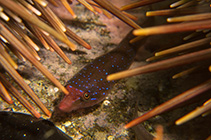| Family: |
Gobiesocidae (Clingfishes and singleslits), subfamily: Trachelochisminae |
| Max. size: |
8.5 cm TL (male/unsexed) |
| Environment: |
demersal; marine; depth range 0 - 15 m |
| Distribution: |
Southwest Pacific: endemic to New Zealand. |
| Diagnosis: |
Dorsal spines (total): 0-0; Dorsal soft rays (total): 8-9; Anal spines: 0-0; Anal soft rays: 8-9. Head and body purple or cream with blue spots. A band of pale color across nape. Distinguished from other clingfishes by its thin lips, exposed flap of skin across the snout and a small fleshy swelling at the base of the pectoral fin. |
| Biology: |
Occurs in rock pools and the subtidal zone. Usually found beneath the spines of sea urchins. Individuals too large to be associated with sea urchins usually found beneath rocks or among shell debris. Feeds mainly on the tube feet and pedicellariae of its host sea urchins, Evechinus chloroticus (Ref. 33548) and on small crustaceans. |
| IUCN Red List Status: |
Not Evaluated (N.E.) Ref. (130435)
|
| Threat to humans: |
harmless |
| Country info: |
|
Source and more info: www.fishbase.org. For personal, classroom, and other internal use only. Not for publication.

